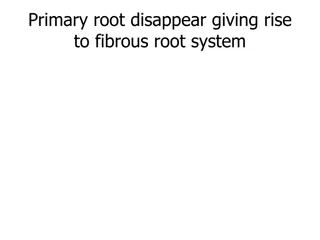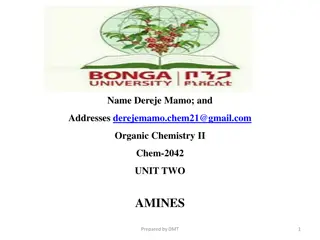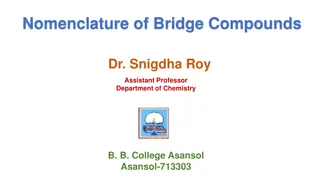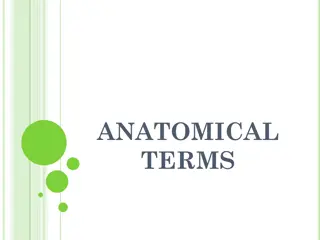Guidelines for Nomenclature of Laboratory Mouse and Rat Strains
Laboratory mice and rat strains have specific nomenclature guidelines to account for their genetic backgrounds and origins. Mouse strains are registered through the Mouse Genome Database, while rat strains are registered through the Rat Genome Database. The use of Laboratory Registration Codes is crucial in identifying the source of strains, and substrains should also be distinguished using these codes. Examples of laboratory codes and institutions involved in strain production are provided, emphasizing the importance of proper nomenclature for inbred strains and hybrids.
Download Presentation

Please find below an Image/Link to download the presentation.
The content on the website is provided AS IS for your information and personal use only. It may not be sold, licensed, or shared on other websites without obtaining consent from the author.If you encounter any issues during the download, it is possible that the publisher has removed the file from their server.
You are allowed to download the files provided on this website for personal or commercial use, subject to the condition that they are used lawfully. All files are the property of their respective owners.
The content on the website is provided AS IS for your information and personal use only. It may not be sold, licensed, or shared on other websites without obtaining consent from the author.
E N D
Presentation Transcript
Couse number AGB 610 Couse number AGB 610 Course Title: Laboratory Animal Breeding Course Title: Laboratory Animal Breeding Guidelines for Nomenclature of Mouse and Rat Strains Guidelines for Nomenclature of Mouse and Rat Strains (Source: http://www.informatics.jax.org/mgihome/nomen/strains.shtml) (Source: http://www.informatics.jax.org/mgihome/nomen/strains.shtml) Instructor: Dr Instructor: Dr Shanker Univ. Professor, AGB Univ. Professor, AGB Shanker Dayal Dayal
Mice and rats used in the laboratory derive from a variety of sources. Production of inbred strains means that these backgrounds can be defined and thus require nomenclature conventions. Nomenclature of mice strain Most laboratory mice have contributions from both Mus musculus musculus and Mus musculus domesticus. There is evidence that smaller contributions also may have come from Mus musculus molossinus and Mus musculus castaneus. Therefore, they should not be referred to by species name, but rather as laboratory mice or by use of a specific strain or stock name. Mouse strain names should be registered through the Mouse Genome Database (MGD) at http://www.informatics.jax.org/mgihome/submissions/amsp_submis sion.cgi.
Nomenclature of rat Nomenclature of rat Laboratory rat strains derive from the Laboratory rat strains derive from the Rattus species, species, Rattus Rattus rattus rattus, also is used as an experimental model, but has not , also is used as an experimental model, but has not contributed to the common laboratory rat strains. contributed to the common laboratory rat strains. Rat strain names should be registered through the Rat Genome Database Rat strain names should be registered through the Rat Genome Database (RGD) at (RGD) at http://rgd.mcw.edu/tools/strains/strainRegistrationIndex.cgi http://rgd.mcw.edu/tools/strains/strainRegistrationIndex.cgi Laboratory code Laboratory code A key feature of mouse and rat nomenclature is the Laboratory Registration A key feature of mouse and rat nomenclature is the Laboratory Registration Code or Laboratory code, which is a code of usually three to four letters Code or Laboratory code, which is a code of usually three to four letters (first letter uppercase, followed by all lowercase) that identifies a particular (first letter uppercase, followed by all lowercase) that identifies a particular institute, laboratory, or investigator that produced, and may hold stocks of, institute, laboratory, or investigator that produced, and may hold stocks of, a mouse or rat strain. a mouse or rat strain. Substrains Substrains should be identified by Laboratory codes, should be identified by Laboratory codes, as should congenic and other strains where several different forms exist as should congenic and other strains where several different forms exist that are not otherwise distinguishable. Laboratory codes are assigned by that are not otherwise distinguishable. Laboratory codes are assigned by the Institute of Laboratory Animal Research (ILAR) the Institute of Laboratory Animal Research (ILAR) ( (http://dels.nas.edu/global/ilar/lab http://dels.nas.edu/global/ilar/lab- -codes codes). ). Rattus norvegicus norvegicus species. Another species. Another
Examples of Laboratory codes are: J The Jackson Laboratory Rl W.L. and L.B. Russell Jr John Rapp Mcw Medical College of Wisconsin Kyo Kyoto University Nomenclature of Inbred Strains and Hybrids Strains can be termed inbred if they have been mated brother x sister for 20 or more consecutive generations, and individuals of the strain can be traced to a single ancestral pair at the 20thor subsequent generation. At this point the individuals' genomes will on average have only 0.01 residual heterozygosity (excluding any genetic drift) and can be regarded for most purposes as genetically identical. Inbred strains must be continuously mated brother x sister (or equivalent) thereafter.
Other Other breeding breeding schemes consecutive consecutive parent younger younger of of the the parents to to parent parent is is subsequently subsequently mated Other Other breeding breeding schemes is is equivalent equivalent to to 20 20 successive Nomenclature Nomenclature of of Inbred An An inbred inbred strain strain should up up of of uppercase, uppercase, Roman, numbers numbers beginning beginning with do do not not follow follow this this convention schemes can parent x x offspring parents is is always can also offspring mating always used mated to to its schemes are are acceptable successive generations Inbred strain strain should be be designated designated by Roman, letters, letters, or or a a combination with a a letter letter. . (Note (Note that convention; ; e e. .g g. ., , mouse mouse strain also be mating may used ( (i i. .e e. ., , the its offspring) offspring). . acceptable provided generations of of sib be used used to to produce may be produce inbred be used, used, provided the offspring offspring that inbred strains provided that that is is mated strains. . that the mated the provided that sib mating mating. . that the the inbreeding inbreeding by a a unique unique brief combination of of letters that some some pre pre- -existing strain 129 129P P1 1/J) brief symbol symbol made letters and existing strains /J). . made and strains Care Care should should be strain strain designations designations. . be taken taken that that mouse mouse and and rat rat strains strains do do not not overlap overlap in in
Inbred Inbred strains F F20 20 are are related relationship relationship. . Example Example Mouse strains: Rat strains: strains that related inbred that have inbred strains, have a a common common origin, strains, and origin, but and symbols symbols should but are are separated separated before should reflect reflect this before this NZB, NZC, NZO SR, SS Indication of Inbreeding Indication of Inbreeding The number of brother x sister inbreeding generations can be he number of brother x sister inbreeding generations can be indicated, if necessary, by addition in parentheses of F followed by indicated, if necessary, by addition in parentheses of F followed by the number of generations. the number of generations. Example Example Rat strain: ACI/N (F159)
If there is not information as to the total number of generations, but a minimum number of If there is not information as to the total number of generations, but a minimum number of recent inbreeding generations is known, this can be shown by a question mark + the known recent inbreeding generations is known, this can be shown by a question mark + the known number of subsequent generations of inbreeding. number of subsequent generations of inbreeding. Example Example Mouse strain: C3H/HeJ-ruf (F?+25) Substrains Substrains Established inbred strains may genetically diverge with time into Established inbred strains may genetically diverge with time into substrains of circumstances: of circumstances: If two branches are separated after 20 but before 40 generations of inbreeding there still will If two branches are separated after 20 but before 40 generations of inbreeding there still will be enough residual heterozygosity that two genetically different be enough residual heterozygosity that two genetically different substrains substrains, due to a number , due to a number substrains will result. will result. If branches are separated for more than 20 generations from a common ancestor, it is likely If branches are separated for more than 20 generations from a common ancestor, it is likely that genetic variation between the branches will have occurred by mutation and genetic drift. that genetic variation between the branches will have occurred by mutation and genetic drift. If genetic differences are proven by genetic analysis to have occurred between branches. If genetic differences are proven by genetic analysis to have occurred between branches. Substrains Substrains are given the root symbol of the original strain, followed by a forward slash and a are given the root symbol of the original strain, followed by a forward slash and a substrain substrain designation. designation.
The designation is usually the Laboratory code of the individual or The designation is usually the Laboratory code of the individual or laboratory originating the strain laboratory originating the strain Example Example Substrain of IS rat strain originating at Kyoto University. Substrain of A mouse strain originating from Walter Heston. IS/Kyo A/He If a laboratory originates more than one If a laboratory originates more than one substrain should be added to the Laboratory code. should be added to the Laboratory code. Example Example substrain, serial numbers , serial numbers Mouse strains: FL/1Re, FL/2Re
Substrains Substrains may maintenance maintenance by new new colony colony. . In In addition, differences differences from from the further further substrain substrain designations another another slash slash. . Example Example may give by a a different different investigator addition, substrains the original original substrain designations are give rise rise to to further investigator or or through substrains arise substrain are are added, added, without further substrains substrains by through establishment arise if if demonstrable demonstrable genetic are discovered discovered. . In In either without the by continued continued establishment of of a a genetic case, either case, the addition addition of of Mouse substrain derived at Harwell (H) from the Heston (He) substrain of C3H. Rat substrain derived at Institute of Physiology, Czech Academy of Sciences (Ipcv) from the John Rapp (Jr) substrain of SR C3H/HeH SR/JrIpcv
Nomenclature Nomenclature of of Hybrid Mice Mice or or rats rats that direction, direction, are are genetically abbreviations abbreviations of of the Note Note that that reciprocal reciprocal F F1 1 hybrids designations designations are, are, therefore, therefore, different Examples Examples Hybrid are the genetically identical, the two two parents that are the progeny progeny of of two identical, and parents (maternal hybrids are different. . two inbred inbred strains, and can can be be designated (maternal strain strain listed are not not genetically genetically identical, strains, crossed designated using listed first), first), followed identical, and crossed in in the using uppercase followed by the same same uppercase by F F1 1. . and their their Mouse that is the offspring of a DBA/2 mother and C57BL6/J father. A full F1 designation is (DBA/2N x C57BL/6J)F1. Mouse that is the offspring of the reciprocal cross. A full F1 designation is (C57BL/6J x DBA/2N)F1. Mouse that is the offspring of two recombinant inbred strains, a CXB1 mother and BXD22 father; full F1 designation is (CXB1/ByJ x BXD22/TyJ)F1. D2B6F1 B6D2F1 CB1BD22F1
Recombinant inbred strain Recombinant inbred (RI) strains contain unique, approximately equal proportions of genetic contributions from two original progenitor inbred strains. Traditionally, recombinant inbred (RI) strains are formed by crossing animals of two inbred strains, followed by 20 or more consecutive generations of brother x sister matings. Alternate breeding schemes can be used, such as creating RI strain sets from Advanced Intercross Lines, where F2 animals are nonsib mated for several generations, followed ultimately by 20 or more consecutive generations of brother x sister matings. Note that if backcrossing to one of the parental strains is involved, this will create recombinant congenic strains and should be named accordingly. RI strains should be designated by uppercase one- or two-letter abbreviations of both parental strain names, with the female strain written first, and separated by an uppercase letter X with no intervening spaces. All members of RI sets involving the same two strains will be serially numbered regardless of whether they were created in one or more laboratories. Sequential numbers may be obtained from MGD. Example Recombinant inbred mouse strain derived from a cross of BALB/c x C57BL/6J. CXB
Multiple Multiple RI RI strains serial serial numbers numbers. . Example Example strains derived derived from from the the same same strain strain progenitors progenitors are are given given Members of the BXD set of mouse RI strains derived from a cross of C57BL/6 x DBA/2. Members of the HXB set of rat RI strains derived from a cross of SHR/OlaIpcv x BN- Lx/Cub. BXD1, BXD2, BXD3 HXB1, HXB2, HXB3 If the second strain abbreviation ends in a number ( If the second strain abbreviation ends in a number (e.g. a hyphen should be used to separate it from the serial number ( a hyphen should be used to separate it from the serial number (e.g. CX8 CX8- -1). 1). e.g., CX8 RI strains), , CX8 RI strains), e.g., ,
Recombinant Congenic strain Recombinant Congenic strain Recombinant Recombinant Congenic Congenic (RC) a a few few (usually (usually two) "recipient" "recipient" strain), strain), with ( (Demant Demant and and Hart, Hart, 1986 Such Such inbred inbred strains strains will with with homozygous homozygous segments on on the the number number of of original (RC) Strains Strains are two) backcrosses backcrosses of of the with subsequent subsequent inbreeding 1986) ). . will consist consist of of the segments of of the the donor original backcrosses, backcrosses, 2 2 backcrosses are formed formed by the hybrids inbreeding without by crossing crossing two hybrids to to one without selection two inbred inbred strains, one of of the the parental selection for for any strains, followed followed by parental strains strains (the any specific specific markers by (the markers the background background recipient donor (the (the amount amount of of donor backcrosses will recipient strain donor strain will give give on strain genome genome interspersed strain genome genome depending on average average 12 12. .5 5% %) ). . interspersed depending RC RC Strains Strains should approximates approximates that backcrossing backcrossing will mating mating. . Thus, Thus, a a strain generations generations of of brother RC RC strains strains should should be strain strain listed listed first, should be that of of a a standard will be be regarded regarded as as being strain produced produced by brother x x sister sister mating be designated designated by first, separated separated by be regarded regarded as as fully standard inbred fully inbred inbred when inbred strain being equivalent equivalent to to two by two two backcrosses backcrosses (N mating (F (F14 14) ) would would be by an an uppercase uppercase abbreviation by lowercase lowercase "c "c. ." " when the strain. . For the theoretical theoretical coefficient For this this purpose, purpose, one two generations generations of of brother (N3 3, , equivalent equivalent to to F F6 6) ) followed be fully fully inbred inbred. . abbreviation of of the the two coefficient of of inbreeding one generation generation of of brother x x sister followed by inbreeding sister by 14 14 two strains, strains, recipient recipient Example Recombinant congenic strain between BALB/c recipient and STS donor CcS
Nomenclature for Transgenic Strains A transgene symbol consist of three parts as follows: TgX (YYYYYY)#####Zzz Tg: Transgenic X: The mode of insertion (Now excluded) (AAA-BBB): AAA = Promoter, BBB = Transcribed sequences ( - now excluded) #####: Laboratory-assigned number Zzz: Laboratory code. Mode of Transgenesis X is a letter designating the mode of insertion of the DNA; N for non-homologous insertion, R for insertion via infection with a retroviral vector, H for homologous recombination. C57BL/6J-TgN(CD8Ge)23Jwg. The non-homologous insertion of human CD8 genomic clone Ge into C75BL/6 mice from the Jackson Laboratory (J); the 23rd mouse screened in a series of microinjections in the laboratory of Jon W Gordon (Jwg).























